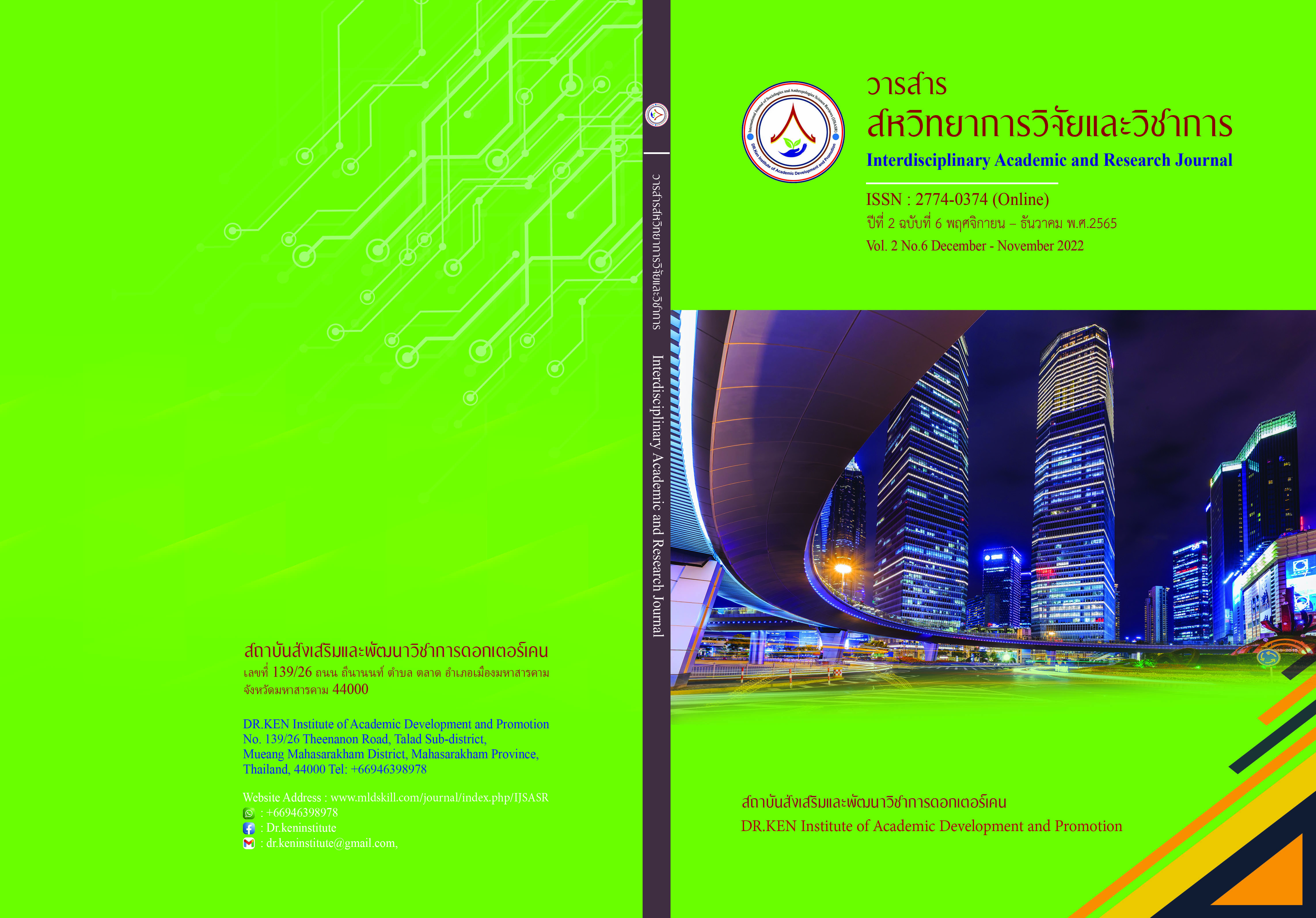Buddhist Public Welfare Promotion Model of Sangha Administrators in the Lower Northeastern Region
DOI:
https://doi.org/10.14456/iarj.2022.174Keywords:
Promotion; , Public Welfare; , Monks; , Lower Northeastern ThailandAbstract
From rural society to online society Still, the monks still have the same roles and duties, more or less depending on the changing factors in society. Including accepting the changes of each society, monks still have many roles and responsibilities in performing their duties because of the faith of the Buddhists. Therefore, the role of monks and helping people in the situation of Kovic-19 Therefore, it is very important to be involved in the lives of Buddhists, either directly or indirectly. Thus, this research was to (1) study the level of public aid promotion of Sangha administrators, (2) study factors affecting the public aid promotion of Sangha administrators, and (3) to establish and confirm the public welfare promotion model of the Sangha administrators. This research was held at the lower northeastern of Thailand. This research was divided into 3 phases: Phase 1 studied the level of public welfare promotion, and factors affecting public welfare promotion of monks by questionnaire 386 monks. The instrument was the 5-rating scale questionnaire. Data were analyzed by descriptive statistics, mean, percentage, standard deviation, and Structural Equation Model (SEM), Phase 2, establish a model for promoting public welfare of Sangha administrators by interviewing the target group 20 persons of experts were academicians, Sangha administrators from provincial, and district level. Phase 3, confirmation of model of public assistance promotion of Sangha administrators by the expert verification. The result found that (1) the public assistance promotion of the Sangha administrators as overall was at a high level, ranking each aspect were assistance, development, support, and integration respectively. (2) Factors affecting public welfare promotion of Sangha administrators as overall by statistical significant at 0.01 level were the personal competency, the external reinforcement, the Sangha Organization Competency which 3 factors can explain the variation in public aid promotion of monks at 48.30% (R2 = 0.483). The relationship of the model of public welfare promotion of the Sangha administrators is consistent with the empirical data, test, p-value = 0.002, x2/df = 1.630, GFI = 0.994, CFI = 0.992, RMSEA = 0.04, SRMR = 0.03. And (3) Buddhist public welfare promotion model of Sangha administrators were as follows: (A) development of personal competency, (B) development of external support, and (C) development of sangha organization competency.
References
พระใบฎีกาสมคิด นาถสีโล, พระมหากฤษฎา กิตฺติโสภโณ, และ พระมหาสุนันท์ สุนนฺโท (2561). บทบาทของพระสังฆาธิการในการช่วยเหลือเกื้อกูลประชาชน. วารสาร มจร สังคมศาสตร์ปริทรรศน์. 7 (2), 246-255.
พระครูเมตตามงคลวิศิษฏ์. (2559). การบริหารงานกิจการคณะสงฆ์ของพระสังฆาธิการในเขตกรุงเทพมหานคร. วารสารสถาบันวิจัยญาณสังวร, 8(2), 59-68.
พระครูใบฎีกาอภิชาติ ธมฺมสุทฺโธ. (2558). ระบบการบริหารกิจการคณะสงฆ์ไทยในทศวรรษหน้า. วารสารครุศาสตร์ปริทรรศน์ฯ, 2(2),126-139.
พระครูปราโมทย์ปัญญาวัฒน์ (บุญเลิศ เตชปุญฺโญ) (2563). การจัดการสาธารณสงเคราะห์ของพระสังฆาธิการ ในอำเภอบางคนทีจังหวัดสมุทรสงคราม. วารสารศิลปะศาสตร์ราชมงคลสุวรรณภูมิ. 2 (1), 383-392.
พระครูปราโมทย์ปัญญาวัฒน์ (บุญเลิศ เตชปุญฺโญ). (2563). การจัดการสาธารณสงเคราะห์ของพระสังฆาธิการกับสภาพการณ์ปัจจุบัน. วารสารศิลปะศาสตร์ราชมงคลสุวรรณภูมิ, 2(2),434.
พระครูวิโรจน์อินทคุณ (เอกชัย อินฺทโชโต). (2563). การพัฒนาสมรรถนะเจ้าอาวาสตามหลักพุทธธรรม เพื่อการบริหารกิจการคณะสงฆ์ในจังหวัดจันทบุรี. วารสาร มจร สังคมศาสตร์ปริทรรศน์, 9(3). 244-257.
พระครูสุธีจริยวัฒน์. (2562). บทบาทของพระสงฆ์ในศตวรรษที่ 21. วารสารวิชาการพระพุทธศาสนาเขตลุ่มแม่น้ำโขง, 2(1), 1-8.
พระบุญทอด สีนวนนา. (2559). ประสิทธิผลการบริหารจัดการของพระวินยาธิการเพื่อความยั่งยืนของคณะสงฆ์ภาค 9. สมาคมสถาบันอุดมศึกษาเอกชนแห่งประเทศไทย ในพระราชูปถัมภ์ สมเด็จพระเทพรัตนราชสุดาฯ สยามบรมราชกุมารี. 22(1), 61-69.
พระมหาชุติภัค อภินนฺโท และรัตติยา เหนืออำนาจ. (2562). การจัดการเครือข่ายวัฒนธรรมเชิงพุทธของคณะสงฆ์ จังหวัดนครพนม เพื่อเสริมสร้างความสัมพันธ์ทางวัฒนธรรมกับประชาคมอาเซียน. วารสารวิจยวิชาการ, 2(3), 1-18.
พระมหาวิวัต ฌาเนสโก (ศิริรัตน์) และคณะ. (2564). การพัฒนาเครือข่ายการบริหารงานของคณะสงฆ์ไทยในทวีปยุโรป. วารสารครุศาสตร์ปริทรรศน์ฯ, 8(1), 336-351.
พระมหาวิศิต ธีรวํโส. (2562). การพัฒนาสมรรถนะของพระสังฆาธิการ ในจังหวัดสุรินทร์. วารสาร มจร พุทธปัญญาปริทรรศน์, 4(1), 161-169.
พระมหาสันติ ฐานวโร. (2561). การประยุกต์ใช้หลักพุทธธรรมในงานสาธารณสงเคราะห์ ของคณะสงฆ์เขตทุ่งครุ กรุงเทพมหานคร. วิทยานิพนธ์ปริญญาพุทธศาสตรมหาบัณฑิต. พระนครศรีอยุธยา: มหาวิทยาลัยมหาจุฬาลงกรณราชวิทยาลัย.
พระราชรัตนเวที (ประเสริฐ โชติธมฺโม). (2560). รูปแบบการพัฒนาสมรรถนะทางการบริหารจัดการของพระสังฆาธิการในเขตปกครองคณะสงฆ์ภาค 4. วารสาร มจร สังคมศาสตร์ปริทรรศน์, 2(6), 523-537.
พระสมุห์วศิน วิสุทฺโธ (พงษ์ศักดิ์) (2563). พระสงฆ์การจัดการงานสาธารณสงเคราะห์: บทบาทและความสำคัญ. วารสารศิลปะศาสตร์ราชมงคลสุวรรณภูมิ. 2 (1), 357-366.
พินิจ ลาภธนานนท์ สายชล ปัญญชิต และภูเบศ วณิชชานนท์. (2564). สังคมวิทยาของพระพุทธศาสนาเพื่อสังคม: บทวิเคราะห์ว่าด้วยงานสาธารณสงเคราะห์วิถีพุทธของคณะสงฆ์ไทย. วารสาร มจร สังคมศาสตร์ปริทรรศน์, 10(2), 25-37.
พินิจ ลาภธนานนท์. (2562). อดีต ปัจจุบัน และอนาคตงานสาธารณสงเคราะห์วิถีพุทธของคณะสงฆ์ไทย. (พิมพ์ครั้งที่ 1). นนทบุรี: นิติธรรมการพิมพ์.
พินิจ ลาภธนานนท์. (2563). ถอดบทเรียนงานสาธารณสงเคราะห์วิถีพุทธของคณะสงฆ์ไทย. กรุงเทพฯ: สถาบันวิจัยพุทธศาสตร์ มหาวิทยาลัยมหาจุฬาลงกรณราชวิทยาลัย.
พิรญาณ์ แสงปัญญา และพินิจ ลาภธนานนท์. (2564). พุทธศาสนาเพื่อสังคม: บทบาทพระสงฆ์ด้านงานสาธารณสงเคราะห์ กรณีศึกษาพระราชธรรมนิเทศ (พระพยอม กลฺยาโณ) วัดสวนแก้ว จังหวัดนนทบุรี. วารสารมหาจุฬานาครทรรศ์, 8(3), 288-302.
Yamane, T. (1973). Statistics: An Introductory Analysis. 3rd Edition. New York: Harper and Row Publications.
Downloads
Published
How to Cite
Issue
Section
License
Copyright (c) 2022 พระครูใบฎีกาวิชาญ วิสุทโธ, ยุภาพร ยุภาศ, เสาวลักษณ์ โกศลกิตติอัมพร

This work is licensed under a Creative Commons Attribution-NonCommercial-NoDerivatives 4.0 International License.
Copyright on any article in the Interdisciplinary Academic and Research Journal is retained by the author(s) under the under the Creative Commons Attribution-NonCommercial-NoDerivatives 4.0 International License. Permission to use text, content, images, etc. of publication. Any user to read, download, copy, distribute, print, search, or link to the full texts of articles, crawl them for indexing, pass them as data to software, or use them for any other lawful purpose. But do not use it for commercial use or with the intent to benefit any business.
















.png)


